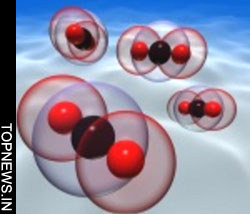CO2 in underground water may bring carbon capture and storage a step closer
 Washington, April 2 : A new research has shown that for millions of years carbon dioxide (CO2) has been stored safely and naturally in underground water in gas fields saturated with the greenhouse gas, a finding that brings carbon capture and storage a step closer.
Washington, April 2 : A new research has shown that for millions of years carbon dioxide (CO2) has been stored safely and naturally in underground water in gas fields saturated with the greenhouse gas, a finding that brings carbon capture and storage a step closer.
Some models predict that CO2 would react with rock minerals to form new carbonate minerals, while others suggest that the gas dissolves into the water.
Real studies to support either of these predictions have, until now, been missing.
To find out exactly how the carbon dioxide is stored in natural gas fields, an international team of researchers - led by the University of Manchester - uniquely combined two specialized techniques.
They measured the ratios of the stable isotopes of carbon dioxide and noble gases like helium and neon in nine gas fields in North America, China and Europe.
These gas fields were naturally filled with carbon dioxide thousands or millions of years ago.
They found that underground water is the major carbon dioxide sink in these gas fields and has been for millions of years.
According to Dr Stuart Gilfillan, the lead researcher who completed the project at the University of Edinburgh, "We've turned the old technique of using computer models on its head and looked at natural carbon dioxide gas fields which have trapped carbon dioxide for a very long time."
"By combining two techniques, we've been able to identify exactly where the carbon dioxide is being stored for the first time," he said.
"We already know that oil and gas have been stored safely in oil and gas fields over millions of years. Our study clearly shows that the carbon dioxide has been stored naturally and safely in underground water in these fields," he added.
"This new approach will also be essential for monitoring and tracing where carbon dioxide captured from coal-fired power stations goes when we inject it underground - this is critical for future safety verification," said Professor Chris Ballentine of the University of Manchester, the project director.
According to Professor Barbara Sherwood Lollar of the University of Toronto and co-author of the study, the new data can be fed into future computer models to make modelling underground carbon capture and storage more accurate. (ANI)